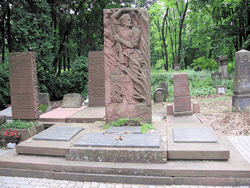The Blones family; Warsaw Ghetto Fighters
Greg R. Tuckman wrote;
My great grandmother, Bina Tuchman nee Blones, was a cousin of Jurek
Blones. Jurek's sister, Guta, and younger brother Lusiek were also
resistance fighters.
I am attaching a short biography on Jurek and Guta Blones. I will
also be completing one on Lusiek, Melech and Izzhok.
Also attached is a photo of Jurek, Guta and Marek Edelman in camp,
circa 1938. Guta is 6th from the left, standing. Jurek is 7th from
the left. Marek Edelman is seated on the far right.
Also attached is their headstone in the Warsaw Jewish Cemetery.
Greg
Jurek Blones was born in Warsaw in 1920 or 1924. He graduated from
the Michaelewicz CISzO school on Mila Street which was a special
underground school in the ghetto. He was ten when he became a member
of Skif and then he belonged to Cufunkt. Jurek was an automobile
mechanic.
In the ghetto he was active in the Bund underground. At first he
printed and distributed newsletters. Afterward he organized the
purchase and transportation of weapons. He used to go in and out of
the ghetto often and was W?adka Meed's contact in the ghetto. He was
slim, quite tall and light-haired. He had what was considered an
Aryan or safe outward appearance. He knew how to jump over the wall
surrounding the ghetto.
Jurek was a hotheaded and it was he who persuaded Michal Klepfisz to
produce Molotov cocktails and bring them to the ghetto. In the April
1943 uprising he was the commander of the fighting group at the site
of the brush maker's factory. Afterward, when the brushes began to
burn, groups led by B?ones, Gutman, Berlinski and Grynszpan, under the
command of Marek Edelman, broke through to the central ghetto on 30
Franciszanska Street.
On May 10, 1943, Guta, Jurek and Lusiek came out through the sewers to
the other side of the ghetto wall. Together with others, they were
transported by vehicle to Lomiany and a few days later to the
Wyszkowski forests. There Jurek became gravely ill. He had a high
fever and it was necessary to get him out of the forest immediately.
It was decided that Zygmunt Frydrych would find him a place in Pludy
where Roska Klog-Wasserman was hiding. Celek Celemenski and probably
Antek Cukierman came to the forest to get Jurek. Once there, they
decided to also take the sickly Cimeret Wachenhojzer, the eighteen
year old Fajgele Goldsztajn, , who was taking particular care of
Jurek, as well as Guta and Lusiek. Zygmunt Frydrych went in a car
with the passengers to Woodrow Wilson Square. Pludy was not far away
on the other side of the Vistula River, at the site of today's Praga
(a suburb of Warsaw). The Polish man who was to hidden them called
the police.
Wladka Peltel, a survivor of the uprising, wrote that the Germans beat
them and led them through Pludy with a sign on their chests which
read: Jewish bandits will be shot. This is how we deal with Jews and
those who help them. All were shot beside a wooden fence, facing the
house of the Pole.
In 1946 they were buried in the Jewish Cemetery in Warsaw: Five
members of the Bund and a girl from the Szomer.
---------------------------
The Central Database of Shoah Victims' Names from Yad Vashem tell us
that Gitla was the daughter of Miriam and born in Warsaw, Poland in
1918. She was a student, single and died in 1943 in the Warsaw
Ghetto.
A biography written by Anka Grupi?ska tells us that Guta was born in
1917 or 1921 in Warsaw. She was the older sister of Jurek and Lusiek.
She studied CISzO and in the technical school ORT. She was active in
the children's Skif (a Jewish organization) and later in the Cukunft
(also a Jewish organization).
Their mother died young, so Guta took care of her brother and the
house. They lived on Smocza Street. In the ghetto, the siblings
stayed together. Guta worked in the community kitchens. In their
house, at 67 Nowolipie Street, they hid a duplicating machine and it
was here that Jurek B?ones and Marek Edelman printed the Jewish Bund
newspapers while the girls distributed them throughout the ghetto.
After the Great Campaign (Action), the B?ones siblings were employed
in the Roerich shed.
In November of 1942, Guta, Jurek, and the youngest, Lusiek, were
captured in the shed and taken to Umschlagpatz. In the train, on the
way to Treblinka, they were with other Bund members including Chajka
Belchatowska. They pried a board from the side of the car and ten
Bund members jumped. The guards opened fire but nobody was hurt. All
of them returned to the ghetto.
In the April 1943 uprising they were together on the site of the brush
maker's factory. Guta ran the housekeeping for the insurgents and
threw grenades together with her brothers. On May 10, 1943, they left
Franciszkanska Street. Using the underground sewers, after many
hours, they got to Prosta Street on the other side of the ghetto wall.
Kazik Rajtazer and Krzaczek drove them by truck to Lomianki.
Afterward they were supposed to join the partisans in the Wyszkowski
forests, however Jurek fell gravely ill. Guta was also sick.
It was decided to hide them in Pludy. Zygmunt Frydrych led them
there. They were betrayed by a Polish man who promised them shelter.
Everyone was shot then and there.

